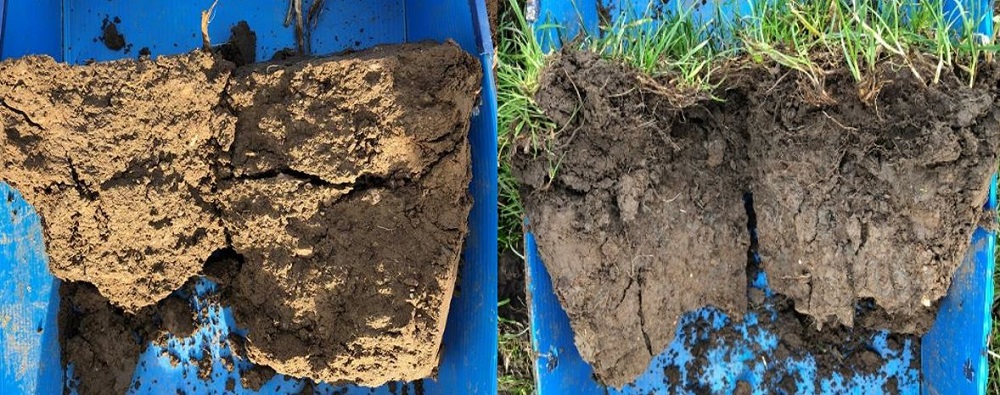[ad_1]
Limavady Monitor Farm
When Limavady Monitor Farm (Carsehall Farm) joined the network in 2022, Farm Manager Alistair Craig was already on course to harmonise the two sides of the business – a fifty–fifty split between dairy and cereal enterprises.
The farm (in County Londonderry) has around 120 ha of land on the sandy loams associated with Lough Foyle – a large tract of land reclaimed from the sea – and a further 80 ha on clay loam soils.
Alistair already put the farm’s manure to good use, reducing the fertiliser requirements for his arable crops and boosting soil organic matter (SOM) levels.
It was a good start, but he wanted to go further and pinpoint the causes of poor crop performance in some fields.
As a result, Alistair grabbed the opportunity to use the soil health scorecard in autumn 2022.
Soil health scorecard
The scorecard uses assessment results for core indicators and compares them to typical ranges for UK soil types and climate regions.
The ranges act as benchmarks and can help reveal if the soil is healthy, getting sick or poorly.
Scorecard indicators
- Visual evaluation of soil structure (VESS)
- pH
- Extractable nutrients (phosphorus, potassium and magnesium)
- Earthworms
- Soil organic matter
Optional indicators also help reveal the size and activity of the soil microbial community – potentially mineralisable nitrogen (PMN) and microbial respiration (CO2 burst).
Alistair wanted to identify constraints to production on his sandy-loam land, which included some poor-performing fields.
In mid-November 2022, soil assessments were done at six sites, with scorecards used to help analyse the results.
It made quite an impression, with some unexpected findings.
Scorecard results
Alistair found the visual evaluation of soil structure (VESS) particularly informative.
VESS is best done on moist soils, so autumn is usually a good time (if it is not too wet).
The approach involves scoring a spade-sized soil block on a 1–5 scale (scoring instructions are detailed in a new AHDB publication).
The scale highlights three performance categories: good (scores 1 and 2), moderate (score 3) and poor (scores 4 and 5).
No soils were in a poor condition, which was a surprise.
For example, sample site 1 was in a field previously used to grow potatoes, which was assumed to be in poor condition.
During the VESS, the field had Alistair’s first crop of winter oilseed rape companion cropped with a mixture of spring beans, sunflowers, vetch and buckwheat.
The average (across three samples) VESS score was 3, which put the field in ‘moderate’ condition. It was not as bad as expected, and rooting was far more extensive than feared.
Rooting in the soil at sampling site 1

AHDB
The cropping diversity had already started to perform its magic on the hard-worked land.
The field also performed relatively well for other indicators, which included a good number of earthworms (the highest number recorded across the six sampling sites).
Most (68%) of these earthworms were young (juvenile), which may indicate that the population was bouncing back from previous cultivations.
When Alistair saw the extent of the rooting, the high number of earthworms and the positive results from the laboratory analysis, he decided to sow the companion crop mix on a third of the farm in the 2022/23 growing season.
Further VESS tests
Encouraged by the soil structure assessments, Alistair used VESS on additional fields.
The sample in the left-hand image (below) showed the clear impact of growing potatoes for two years. The soil was in poor structural condition, with very few pores and roots.
The field was planted with cereals in autumn 2022, which performed poorly.
Alistair said:
“Looking at the photograph of the soil profile, it’s not hard to see why the crop struggled to grow in this field.”
It was a cry for help, so Alistair reviewed the rotation to help the field recover. He took the field out of cereals and grew an eight-species cover crop mix, followed by a cash crop in the spring.
The sample in the right-hand image revealed a distinct compaction layer under the topsoil, so Alistair subsoiled the field.
Problems detected by VESS

AHDB
Other issues
The scorecard highlighted many areas that required attention (Table 1), including some indicators that warranted immediate investigation (I) in some fields.
For example, some of these red flags were associated with low earthworm numbers and nutrient levels far beyond the optimum for the soil.
Table 1. Soil assessment results for six sampling sites in the soil health scorecard, which uses benchmark values to indicate whether areas would benefit from continued monitoring (CM), review (R) or investigation (I).
All sample fields in combinable cropping, except sample 3 (permanent pasture).

AHDB
Alistair felt the approach was worthwhile and has already made several changes on the farm.
He will continue to routinely review soil health, which will help monitor the impact of the boosted companion crop area.
A full soil health scorecard review will also be done in the Monitor Farm’s final year.
Use the scorecard
[ad_2]
Source link
